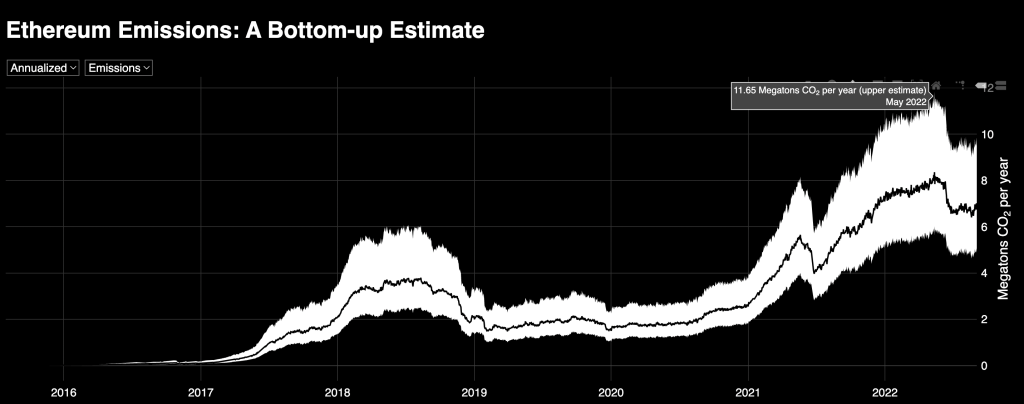Most NFTs will become eco-friendly with the Merge as Ethereum houses the largest Non-Fungible Token (NFT) volume right now—over 80%, according to The Block’s analytics.
The graph below shows the NFT spread across chains. Ethereum takes the cake followed by Solana.

Source: The Block
Ethereum is adopting the Proof-of-Stake (PoS) mechanism of verifying transactions in the near future and will become 99.95% more energy-efficient. As a result of the change, NFT minting, in turn, will also require less energy. Ethereum’s transition will thus positively impact the NFT market.
NFTs, however, were also part of the reason for Ethereum’s large carbon footprint. The profile-picture mania in 2021, followed by increased dApp concentration, increased Ethereum’s emissions, which peaked at 11.65 Megatons in emitted carbon/year in May 2022.

Source: Kylemcdonald.github.io
What does this mean for NFT adoption?
In the past, we have seen several notable NFT projects being scrapped due to their association with Ethereum, which was seen as an energy-guzzling crypto. For example, GSC Game World—a repeated indie game developer based out of Ukraine—had to pull out of an upcoming game because it owned NFT-based gaming assets. The Merge might be the right step toward making NFTs more approachable and acceptable.
Ethereum’s transition might usher NFTs into an era of increased adoption, even among environmentalists. Damien Schuster, co-founder at Offsetra, a carbon offsetting firm, says that several companies and firms have been reluctant to use Ethereum due to the anti-environment narrative. He expects the Merge to change that.
FAQs
What is the carbon footprint of NFT?
The carbon footprint of NFTs (Non-Fungible Tokens) is a topic of concern due to their energy-intensive nature. Here’s a concise overview:
Significant Impact: NFTs contribute to environmental concerns with their carbon footprint, mainly attributed to the energy-intensive process of creating and consuming digital assets.
Energy Consumption: The process of minting NFTs and transactions on blockchain networks, notably Ethereum, consumes substantial energy, leading to concerns about their overall environmental impact.
Individual NFT Footprint: A single artist’s multi-edition NFTs were reported to create a carbon footprint of 260 MWh and 160 tons of CO2 emissions in less than six months.
Average Footprint: An analysis of approximately 18,000 NFTs found that the average NFT’s carbon footprint is equivalent to more than a month of electricity usage.
How can we make NFT eco-friendly?
To make NFTs eco-friendly, consider the following strategies:
Choose Energy-Efficient Blockchains: Opt for blockchains with lower energy consumption, such as Solana or Tezos.
Use Sustainable Platforms: Explore NFT platforms actively working to reduce the environmental impact of NFTs.
Create Sustainable Platforms: For artists, choose blockchain platforms that are environmentally conscious for minting and selling CryptoArtworks (NFTs).
Opt for Sustainable Materials: When digitizing physical pieces for NFTs, use sustainably sourced materials, such as recycled paper, to minimize the ecological footprint.
Are there environmentally friendly NFTs?
While environmental concerns exist, ongoing developments and eco-friendly alternatives offer ways to mitigate the environmental impact of NFTs.
What are the environmental impacts of NFTs?
NFTs (Non-Fungible Tokens) have environmental impacts primarily related to their underlying blockchain technology. Here’s a concise overview:
Energy Consumption: NFTs, built on blockchain, often use Proof of Work (PoW) consensus mechanisms, contributing to high energy consumption. Mining and validating transactions demand substantial computing power, raising environmental concerns.
Carbon Footprint: Despite their digital nature, NFTs leave a carbon footprint due to energy-intensive processes. The carbon impact can be significant, comparable to traditional industries.
Climate Impact: NFTs indirectly affect climate change through their production methods, as seen in the carbon emissions associated with the broader blockchain technology








